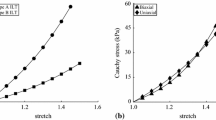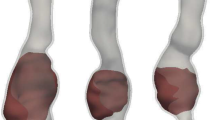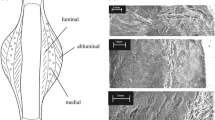Abstract
The reliable assessment of Abdominal Aortic Aneurysm rupture risk is critically important in reducing related mortality without unnecessarily increasing the rate of elective repair. Intra-luminal thrombus (ILT) has multiple biomechanical and biochemical impacts on the underlying aneurysm wall and thrombus failure might be linked to aneurysm rupture. Histological slices from 7 ILTs were analyzed using a sequence of automatic image processing and feature analyzing steps. Derived microstructural data was used to define Representative Volume Elements (RVE), which in turn allowed the estimation of microscopic material properties using the non-linear Finite Element Method. ILT tissue exhibited complex microstructural arrangement with larger pores in the abluminal layer than in the luminal layer. The microstructure was isotropic in the abluminal layer, whereas pores started to orient along the circumferential direction towards the luminal site. ILT’s macroscopic (reversible) deformability was supported by large pores in the microstructure and the inhomogeneous structure explains in part the radially changing macroscopic constitutive properties of ILT. Its microscopic properties decreased just slightly from the luminal to the abluminal layer. The present study provided novel microstructural and micromechanical data of ILT tissue, which is critically important to further explore the role of the ILT in aneurysm rupture. Data provided in this study allow an integration of structural information from medical imaging for example, to estimate ILT’s macroscopic mechanical properties.









Similar content being viewed by others
References
Adolph, R., D. A. Vorp, D. L. Steed, M. W. Webster, M. V. Kameneva, and S. C. Watkins. Cellular content and permeability of intraluminal thrombus in abdominal aortic aneurysm. J. Vasc. Surg. 25:916–926, 1997.
Arita, T., N. Matsunaga, K. Takano, S. Nagaoka, H. Nakamura, S. Katayama, N. Zempo, and K. Esato. Abdominal aortic aneurysm: Rupture associated with the high-attenuating crescent sign. Radiology 204:765–768, 1997.
Bengtsson, H., B. Sonesson, and D. Bergqvist. Incidence and prevalence of abdominal aortic aneurysms, estimated by necropsy studies and population screening by ultrasound. Ann. N.Y. Acad. Sci., 800:1–24, 1996.
Bosch, J. L., J. S. Lester, P. M. McMahon, M. T. Beinfeld, E. F. Halpern, J. A. Kaufman, D. C. Brewster, and G. S. Gazelle. Hospital costs for elective endovascular and surgical repairs of infrarenal abdominal aortic aneurysms. Radiology 220:492–497, 2001.
Breuls, R. G., B. G. Sengers, C. W. Oomens, C. V. Bouten, and F. P. Baaijens. Predicting local cell deformations in engineered tissue constructs: a multilevel finite element approach. J. Biomech. Eng. 124:198–207, 2002.
Choke, E., G. Cockerill, W. R. Wilson, S. Sayed, J. Dawson, I. Loftus, and M. M. Thompson. A review of biological factors implicated in abdominal aortic aneurysm rupture. Eur. J. Vasc. Endovasc. Surg. 30:227–244, 2005.
di Martino, E. S., S. Mantero, F. Inzoli, G. Melissano, D. Astore, R. Chiesa, and R. Fumero. Biomechanics of abdominal aortic aneurysm in the presence of endoluminal thrombus: experimental characterization and structural static computational analysis. Eur. J. Vasc. Endovasc. Surg. 15:290–299, 1998.
Gasser, T. C., M. Auer, and J. Biasetti. Structural and hemodynamical analysis of aortic aneurysms from computerized tomography angiography data. In: Proceedings of the World Congress 2009 – Medical Physics and Biomedical Engineering, September 7–12, Munich, Germany, 2009.
Gasser, T. C., G. Görgülü, M. Folkesson, and J. Swedenborg. Failure properties of intra-luminal thrombus in abdominal aortic aneurysm under static and pulsating mechanical loads. J. Vasc. Surg. 48:179–188, 2008.
Guliak, F., and V. C. Mow. The mechanical environment of the chondrocyte: a biphasic finite element model of cell-matrix interactions in articular cartilage. J. Biomech. 33:1663–1673, 2000.
Hans, S. S., O. Jareunpoon, M. Balasubramaniam, and G. B. Zelenock. Size and location of thrombus in intact and ruptured abdominal aortic aneurysms. J. Vasc. Surg. 41:584–588, 2005.
Inzoli, F., F. Boschetti, M. Zappa, T. Longo, and R. Fumero. Biomechanical factors in abdominal aortic aneurysm rupture. Eur. J. Vasc. Surg. 7:667–674, 1993.
Jonk, Y. C., R. L. Kane, F. A. Lederle, R. MacDonald, A. H. Cutting, and T. J. Wilt. Cost-effectiveness of abdominal aortic aneurysm repair: a systematic review. Int. J. Technol. Assess. Health Care 23:205–215, 2007.
Kazi, M., J. Thyberg, P. Religa, J. Roy, P. Eriksson, U. Hedin, and J. Swedenborg. Influence of intraluminal thrombus on structural and cellular composition of abdominal aortic aneurysm wall. J. Vasc. Surg. 38:1283–1292, 2003.
Kazi, M., C. Zhu, J. Roy, G. Paulsson-Berne, A. Hamsten, J. Swedenborg, U. Hedin, and P. Eriksson. Difference in matrix-degrading protease expression and activity between thrombus-free and thrombus-covered wall of abdominal aortic aneurysm. Arterioscler. Thromb. Vasc. Biol. 25:1341–1346, 2005.
Li, Z.-Y., J. U-King-Im, T. Y. Tang, E. Soh, T. C. See, and J. H. Gillard. Impact of calcification and intraluminal thrombus on the computed wall stresses of abdominal aortic aneurysm. J. Vasc. Surg. 47:928–935, 2008.
Malvern, L. E. Introduction to the Mechanics of a Continuous Medium. New Jersey: Prentice-Hall, Englewood Cliffs, 1969.
Mower, W. R., W. J. Quiñones, and S. S. Gambhir. Effect of intraluminal thrombus on abdominal aortic aneurysm wall stress. J. Vasc. Surg. 33:602–608, 1997.
Newman, A. B., A. M. Arnold, G. L. Burke, D. H. O’Leary, and T. A. Manolio. Cardiovascular disease and mortality in older adults with small abdominal aortic aneurysms detected by ultrasonography: the cardiovascular health study. Ann. Intern. Med. 134:182–190, 2001.
Ogden, R. W. Non-linear Elastic Deformations. New York: Dover, 1997.
Roy, J., F. Labruto, M. O. Beckman, J. Danielson, G. Johansson, and J. Swedenborg. Bleeding into the intraluminal thrombus in abdominal aortic aneurysms is associated with rupture. J. Vasc. Surg. 48:1108–1113, 2008.
Simão da Silva, E., A. J. Rodrigues, E. Magalhães Castro de Tolosa, C. J. Rodrigues, G. Villas Boas do Prado, and J. C. Nakamoto. Morphology and diameter of infrarenal aortic aneurysms: a prospective autopsy study. Cardiovasc. Surg. 8:526–532, 2000.
Swedenborg, J., F. Labruto, and J. Roy. Bleeding into the thrombus in ruptured abdominal aortic aneurysms. In: More Vascular and Endovascular Challenges, edited by R. M. Greenhalgh. London: BIBA Publishing, 2007, pp. 63–67.
Upchurch Jr., G. R., and T. A. Schaub. Abdominal aortic aneurysm. Am. Fam. Physician 73:1198–1204, 2006.
Vardulaki, K. A., T. C. Prevost, N. M. Walker, N. E. Day, A. B. Wilmink, C. R. Quick, H. A. Ashton, and R. A. Scott. Growth rates and risk of rupture of abdominal aortic aneurysms. Br. J. Surg. 85:1674–1680, 1998.
Vorp, D. A., P. C. Lee, D. H. Wang, M. S. Makaroun, E. M. Nemoto, S. Ogawa, and M. W. Webster. Association of intraluminal thrombus in abdominal aortic aneurysm with local hypoxia and wall weakening. J. Vasc. Surg. 34:291–299, 2001.
Vorp, D. A., and J. P. Vande Geest. Biomechanical determinants of abdominal aortic aneurysm rupture. Arterioscler. Thromb. Vasc. Biol. 25:1558–1566, 2005.
Wang, D. H., M. S. Makaroun, M. W. Webster, and D. A. Vorp. Mechanical properties and microstructure of intraluminal thrombus from abdominal aortic aneurysm. J. Biomech. Eng. 123:536–539, 2001.
Wang, D. H., M. S. Makaroun, M. W. Webster, and D. A. Vorp. Effect of intraluminal thrombus on wall stress in patient-specific models of abdominal aortic aneurysm. J. Vasc. Surg. 36:598–604, 2002.
Zienkiewicz, O. C., and R. L. Taylor. The Finite Element Method. The Basis, Vol. 1, 5th edn. Oxford: Butterworth Heinemann, 2000.
Acknowledgments
We would like to thank Sebastian Günther for his contributions regarding image processing and Jacopo Biasetti for his valuable comments about Matlab R2007a (TheMathworks). This work has been supported by the Young Faculty Grant No. 2006-7568 provided by the Swedish Research Council, VINNOVA and the Swedish Foundation for Strategic Research, and the EC Seventh Framework Programme, Fighting Aneurysmal Disease (FAD-200647), which is gratefully acknowledged.
Author information
Authors and Affiliations
Corresponding author
Rights and permissions
About this article
Cite this article
Gasser, T.C., Martufi, G., Auer, M. et al. Micromechanical Characterization of Intra-luminal Thrombus Tissue from Abdominal Aortic Aneurysms. Ann Biomed Eng 38, 371–379 (2010). https://doi.org/10.1007/s10439-009-9837-4
Received:
Accepted:
Published:
Issue Date:
DOI: https://doi.org/10.1007/s10439-009-9837-4




